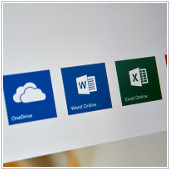Microsoft’s Office 365 platform isn’t one of the most popular productivity suites in the world by luck. The company’s expertise in creating functional, innovative and easy-to-use business applications has won over thousands of users for decades even before the cloud. And today, Microsoft strives to remain ahead of the competition by rolling out new upgrades […]
 Microsoft’s Office 365 platform isn’t one of the most popular productivity suites in the world by luck. The company’s expertise in creating functional, innovative and easy-to-use business applications has won over thousands of users for decades even before the cloud. And today, Microsoft strives to remain ahead of the competition by rolling out new upgrades every quarter. So what does Office 365’s update have in store for you this quarter? Read on and find out.
Microsoft’s Office 365 platform isn’t one of the most popular productivity suites in the world by luck. The company’s expertise in creating functional, innovative and easy-to-use business applications has won over thousands of users for decades even before the cloud. And today, Microsoft strives to remain ahead of the competition by rolling out new upgrades every quarter. So what does Office 365’s update have in store for you this quarter? Read on and find out.
Word
This quarter, Office 365’s upgrade will focus on cloud-powered intelligent services, designed to maximize productivity while saving time. And Office 365’s upgrade wouldn’t be an upgrade if there were nothing new in Word, the business application that put Microsoft on the map. To that end, Word is getting two new features called Researcher and Editor. As you may have guessed, Researcher is designed to help you find reliable sources of information by using Bing’s Knowledge Graph to help search and then cite sources in your Word document. In the future, Researcher’s body of reference materials will also include sources such as national science and health centers, well-known encyclopedias, and more. The feature will be available on mobile devices too.Now that you have Researcher to help you start your paper, you can count on Editor to help you finish it. This new feature builds on the existing spellchecker and thesaurus, and in addition to the wavy red line under a misspelled word and wavy blue line under bad grammar, Editor uses a gold line for suggestions on how to improve your writing.
PowerPoint
Currently, when making a presentation, you’re forced to use the 1-2-3-4 linear method of showing your slides. The problem is that you can’t change your presentation order as needed without having to exit PowerPoint’s slideshow mode, and let’s face it, sometimes you do make mistakes and need to go back or move to a different slide. But thanks to PowerPoint’s new feature, Zoom, you can now present your slides in any order you want at any time without a hiccup.Outlook
The time has come for Office 365’s Outlook to get the Focused Inbox which has been available for iOS and Android for some time now. If you’re not familiar with Focused Inbox, the feature separates your inbox into two tabs: Focused tab which includes emails that matter most to you and the “Other” tab for everything else. This makes it easy to identify email that needs your attention so you never miss anything important.Not only that, but as you move email in or out of the Focused tab, Outlook learns from your behavior and adjusts to your priorities. You can also flag someone by typing the @ symbol in the body of the email and pick whoever you wish to flag. This will automatically highlight that person’s email and their email address will be added to the To: line. If you are mentioned, the @ symbol will show up in Outlook so you can quickly find all email where you are mentioned.
For now, Microsoft hasn’t set a release schedule for these new features, but according to Kirk Koenigsbauer, Corporate Vice President for the Office team, you can expect to use them soon enough! And as always, if you would like to find out how you can make the most out of Office 365 or Microsoft Office, contact us and we’ll be happy to help.

 Microsoft’s Azure and Citrix’s XenApp have done a lot to move virtualization services into the mainstream over the years. So, with the announcement that the two companies will work together to combine their platforms into a new cloud-based application delivery system, it’s understandable why there is so much excitement within the industry. Let’s dig deeper into this new service and what it means for your business.
Microsoft’s Azure and Citrix’s XenApp have done a lot to move virtualization services into the mainstream over the years. So, with the announcement that the two companies will work together to combine their platforms into a new cloud-based application delivery system, it’s understandable why there is so much excitement within the industry. Let’s dig deeper into this new service and what it means for your business. In the Trojan War, a wooden horse wheeled into the city of Troy. Once night fell, the Greek army crept out of the hollow stallion and opened the city’s gates. Having breached the mighty fortress, the entire regiment eventually sealed their victory against the Trojans and won the war. The moral of the story is that pretty objects are able to conceal the most malicious of intentions. The same goes for the most secure operating systems; you should never lower your guard down even for the littlest things.
In the Trojan War, a wooden horse wheeled into the city of Troy. Once night fell, the Greek army crept out of the hollow stallion and opened the city’s gates. Having breached the mighty fortress, the entire regiment eventually sealed their victory against the Trojans and won the war. The moral of the story is that pretty objects are able to conceal the most malicious of intentions. The same goes for the most secure operating systems; you should never lower your guard down even for the littlest things. When most people think of the iPhone, an Excel spreadsheet isn’t exactly the first thing that springs to mind. Whether it was the smartphone’s form factor or a general aversion to working from a mobile device, most of us had no reason to search out iOS versions of Microsoft’s legendary productivity software. Nowadays, screens have more space, and working outside office hours has become commonplace. Along with these developments, Office apps have been steadily getting better, and the most recent update is another pleasant surprise -- let’s take a look.
When most people think of the iPhone, an Excel spreadsheet isn’t exactly the first thing that springs to mind. Whether it was the smartphone’s form factor or a general aversion to working from a mobile device, most of us had no reason to search out iOS versions of Microsoft’s legendary productivity software. Nowadays, screens have more space, and working outside office hours has become commonplace. Along with these developments, Office apps have been steadily getting better, and the most recent update is another pleasant surprise -- let’s take a look.